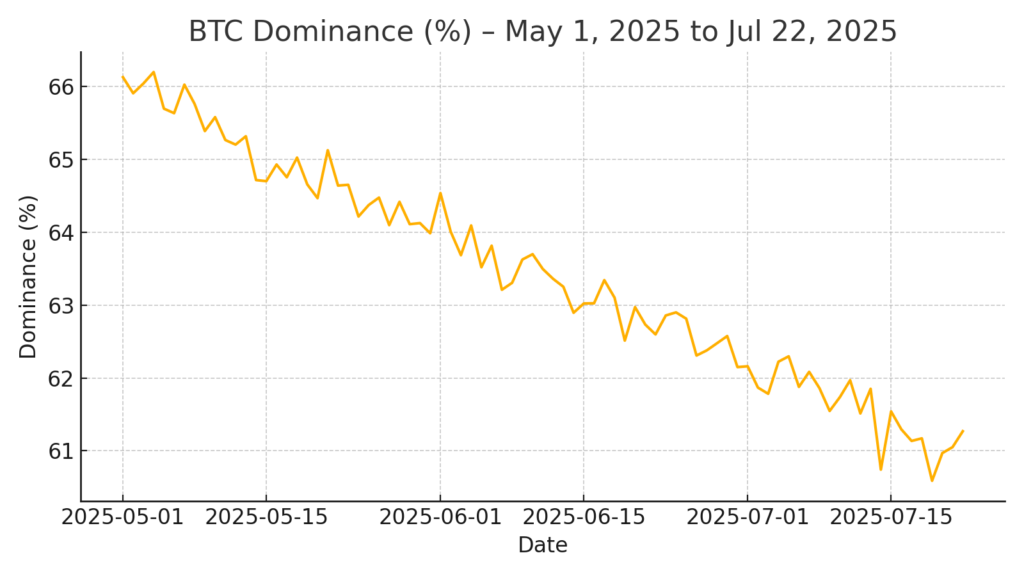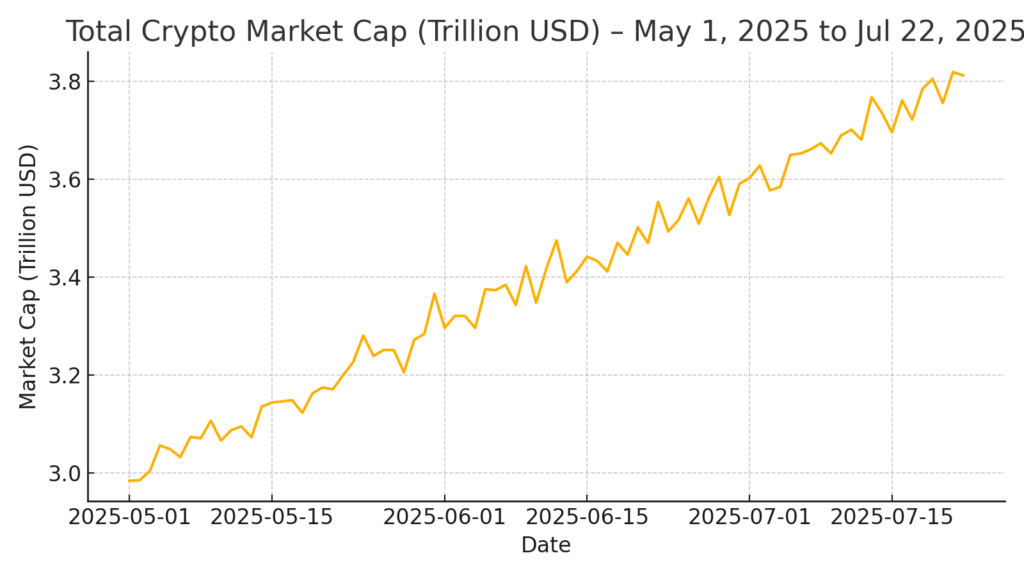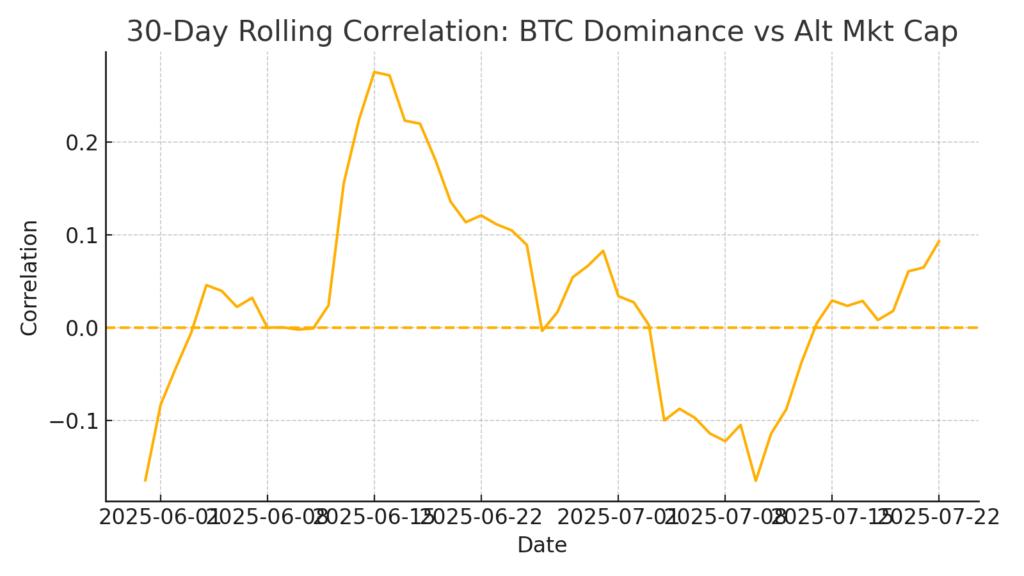
Main Points :
- BTC dominance fell ~5.8% in a week to just under 61%—the sharpest weekly slide since June 2022.
- Total crypto market cap jumped to about $3.8 trillion in three weeks, led by Ethereum and other altcoins.
- BTC–altcoin correlation is collapsing, historically a precursor to higher volatility and forced liquidations.
- “Unit bias” is again steering retail capital toward low-priced tokens and meme coins.
- For builders and investors hunting new revenue streams, the dispersion of returns means niche narratives (real-world assets, DePIN, AI, restaking, gaming) can outperform even if BTC stalls.
- Risk: decoupling increases liquidation cascades and cross-market whipsaws—tight risk controls and staggered entries are essential.
1. The Stat That Shook the Week: BTC Dominance Down 5.8%
Bitcoin’s share of total crypto capitalization slid by roughly 5.8% in just seven days, dropping to a hair below 61%, its lowest since March and the steepest weekly fall since June 2022. This isn’t merely a rounding error; it’s a structural tell that traders are reallocating capital away from BTC and into a broader altcoin basket.

2. $3.8 Trillion and Counting: Altcoins Lead the Charge
While BTC ceded ground in dominance, the overall crypto market cap ballooned from about $3.0 trillion to $3.8 trillion in three weeks—an ~$800 billion influx. Ether (ETH) spearheaded gains, with other majors (SOL, UNI) and high-beta sectors following suit. The macro backdrop—legislative tailwinds like the U.S. “Genius Act” around stablecoins—has also buoyed sentiment.

3. Correlation Breakdown: Why It Matters More Than You Think
According to CoinDesk and follow-up analyses, the average correlation between BTC and altcoins is rapidly sinking, potentially even flipping negative. In plain English: altcoins are no longer simply “high-beta BTC.” Historically, such decoupling precedes volatility spikes and mass liquidations as leveraged bets misprice cross-asset moves.

4. The Psychology Fueling Rotation: Unit Bias Returns
As BTC trades above $120,000, newcomers prefer “owning more units” of cheaper tokens—a cognitive trap known as unit bias. This bias often drives inflows to low-priced meme coins and micro-cap narratives, reinforcing altcoin rallies and further depressing BTC dominance.
5. Opportunities for Builders & Hunters of New Revenue Streams
For readers chasing the “next thing,” dispersion is good news:
- Real-World Assets (RWA): Tokenized T-bills and invoices continue to gain traction as yields stay attractive.
- DePIN & AI Tokens: Decentralized compute/storage (e.g., GPU marketplaces) benefits from AI demand; decoupling lets these tokens run independent cycles.
- Restaking / L2 Yield Plays: Capital rotating out of BTC looks for sustainable yield—EigenLayer-style restaking and L2 sequencer revenue share tokens fit that bill.
- Gaming & Meme Economies: Unit bias plus viral loops equals sticky communities.
These sectors thrive when correlations are low—idiosyncratic catalysts (mainnets, token unlocks, fee distribution flips) can move prices irrespective of BTC’s micro-moves.
6. Risk Management in a De-Synchronized Market
Correlation breakdowns are double-edged: opportunity and hazard. With leverage abundant, sudden rotations can trigger cascading liquidations across perps and options. Practical steps:
- Position Sizing & Staggered Entries: Avoid all-in bets; slice entries across time and liquidity zones.
- On-Chain Liquidity Checks: For smaller caps, watch DEX liquidity depth to estimate slippage risk.
- Hedge Correlation, Not Just Direction: Consider pairs trades (e.g., long narrative token/short sector index) to isolate alpha.
- Monitor Funding & OI: Spiking funding + falling correlation is a classic blow-off setup.
7. Tactical Playbook for the Coming Weeks
- Screen for Low-Cap Narratives With Real Cash Flows: Revenue-sharing dApps, protocol fee tokens, and infra providers in growth niches.
- Track Regulatory Catalysts: Stablecoin legislation and ETF flows remain macro drivers.
- Correlation Heatmaps as Early Warning: If BTC–alt correlation dives below zero, tighten stops; if it snaps back, expect sharp mean reversion.
- Mind Unit Bias in Your Marketing/Tokenomics: Builders can leverage smaller unit prices or subunits (e.g., gwei-style) to appeal to retail—just don’t deceive.
8. Conclusion: A Market of Many Cycles
Bitcoin’s dominance dip is not an obituary—it’s a reminder that crypto is a multi-threaded market. As BTC pauses near record highs, capital is scouting yield, narratives, and psychological comfort elsewhere. The broken correlation regime can mint fortunes—or erase them—faster than synchronized bull runs. Allocate with intent, respect the data, and remember: the cheapest-looking token may be the costliest lesson.

